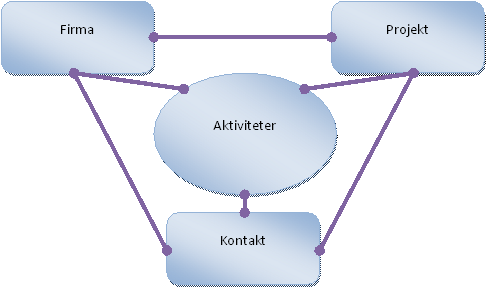CRM is an abbreviation of Customer Relationship Management.
In a world that seems crowded with US acronyms and buzzwords whose main reason is to increase revenue for large IT vendors, there are many who think of CRM as "just another smart thing created to make money".
Although there is a certain amount of truth to this statement, there is also much common sense in CRM and customer care. Of course, your customers should feel just as well treated by you as of your competitors. And of course you can always work more efficiently. It can be so in all other disciplines, so why not in sales and customer care.
What is CRM?
Customer Relationship Management as a term is almost self-explanatory. Still, you will see many versions of explanations if you ask suppliers and colleagues.
In this guide, we define CRM as handling all the connections and actions between your company and persons in other companies, with the aim of achieving something.
"Other companies" can of course be your customers. But it can also be prospects or related companies that have impact on your sales to: Competitors, suppliers, partners, the subjects other suppliers ...
To "achieve something" can of course be selling. But it may well be related things: to extend a message, to establish contact, to get the subject to do something.
How will you benefit from CRM?
Bottom line, the purpose of CRM is to achieve more than you would without having CRM. Be it sales to existing customers or new prospects.
More specific, we can also point to some day-to-day business areas benefitting from CRM:
•Overview of all relations with a customer
•Cooperation vendor-vendor, vendor-consultant, sales manager
•Prioritizing your time and activities
•Protection of the Information
•Efficiency in work
•Credible forecasts
•Control of communication - including e-mails
•Effective campaign management
•Leveraging customer information - up-selling, cross-selling, account control
•Overview of activity levels
•Overview of progress - it is too late to meassure progress solely as revenue
•Reporting to the Board
•Knowledge sharing and avoidance of personal dependencies
•...
And the list could be continued indefinitely (almost). CRM is much more than sending direct mails or to get a list of who bought "Product A" last year.
CRM-data Structure
In a CRM system, one would like to be sure that data is correct, maintained safely and linked in a way reflection rela life. As an example a company is not just an address. It is also all the people you have contacted with the company, so are the documents sent to and from the company or employees, so are the activities we had together and it's ... Well the list is long. The point is that you want to make sure that all these relations will continue to be linked correctly.
To ensure this, we use what is called a relational database. Briefly, a database is a computer program designed to ensure that data can be stored and retrieved. And there may be rules for how data is saved, deleted or updated. In the case of ChannelCRM this means that all users can access the data at the same time and that it is database program that governs that data is always stored properly and in accordance with business rules.
In the database, we make sure to store data in a way that is the best model of the real world. There may be many companies (like all 500,000 Danish) and for each company there may be many employees. Each staff member is linked to the employing company and therefore a change in the company's main telephone number will affect all employees. The main phone number is stored only in one place.

Figur 1: Struktur i data
In the figure is shown how data is divided in separate areas depending on what the data applies to. As an example the name of the company, the address and main telephone number will be stored in an entity named "Company". Whereas person names, e-mail-addressen wil be stored in another type of entity "Contact" related to Company in a way that one company can have zero, one or many contacts (employees).
Companies |
|||
Company |
Phone |
Address |
Company ID |
Danfoss |
4566 3377 |
Nymarksvej 65 |
1 |
Lego |
7654 7654 |
Vejlegade 11 |
2 |
Contacts |
||||
Name |
Company ID |
Title |
Mobile |
Notes |
Søren Olesen |
1 |
Adm. Dir. |
2021 4314 |
Han har også … |
Inger Fredsted |
2 |
Adm. Dir. |
7866 5434 |
Inger startede hos … |
Søren Olsen |
1 |
Teknikchef |
5655 5555 |
Ansvar for pumper … |
Albert Hugo |
2 |
Partner |
2134 5533 |
Var med fra starten … |
On a moer detailled level, you will notice that ChannelCRM data is not only in 4 tables. In fact there are well above 100 tables. This is so because the methodology of dividing data in logically different - but interrelated entities has proven to be a very robust and efficiet way of ensuring validity of data. Both short term and long term ((maintainability).
Using ChannelCRM you do not have to know into details how data are stored. The program will make sure that your data is shown in the expected context.
On a screen showing contacts information, you will also be able to see for instance the main telephone number of the employing company. And on a company screen, you will see documents reltated to said company as well as documents (mails) sendt to or from any of the employees to the company.
URL of this topic:
https://channelcrmhelp.com/index.html?crm_about_crm.htm